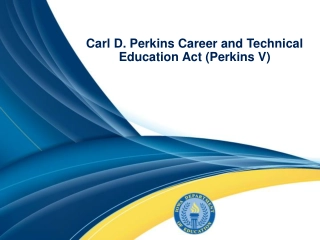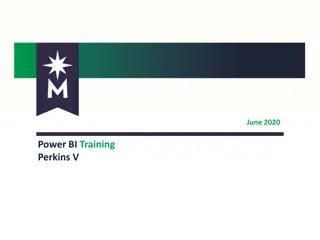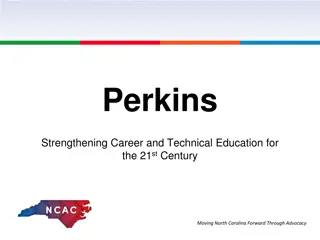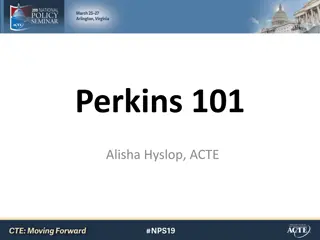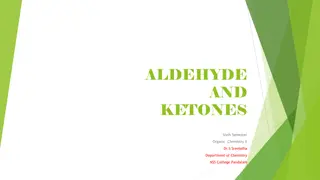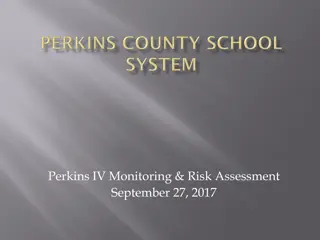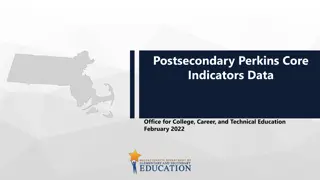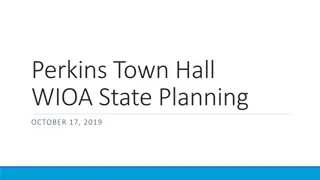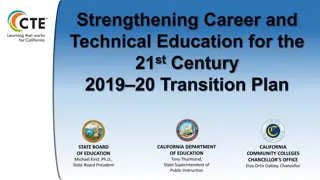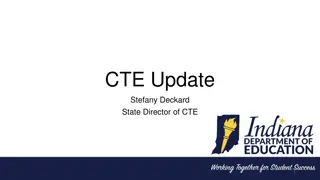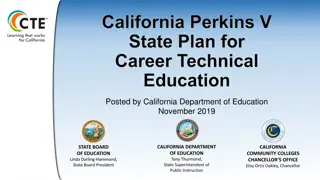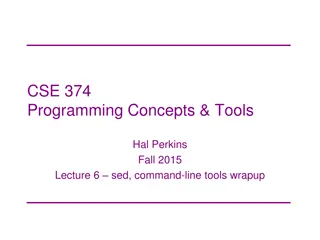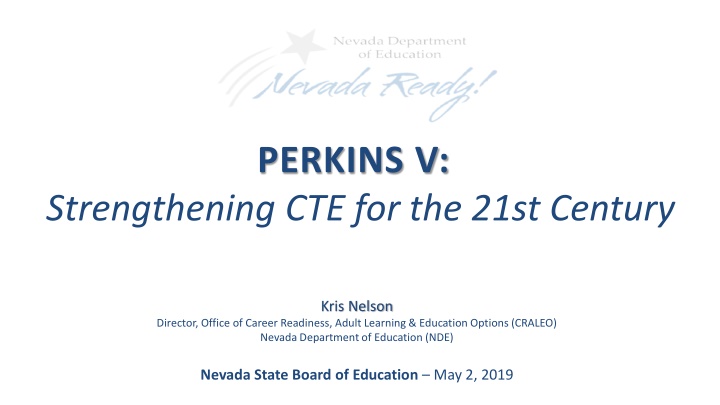
Strengthening Career and Technical Education with Perkins V Act
Learn about the Perkins V Act, which focuses on enhancing CTE programs for the 21st century by emphasizing employer engagement, high-skill pathways, and state flexibility. Explore the major tenets, state plans, and development structure under Perkins V, highlighting the importance of continuing CTE program improvement and accountability. Discover the key highlights of the Act, including governance structure retention, funding formulas, and system alignment with other education legislation.
Uploaded on | 0 Views
Download Presentation

Please find below an Image/Link to download the presentation.
The content on the website is provided AS IS for your information and personal use only. It may not be sold, licensed, or shared on other websites without obtaining consent from the author. If you encounter any issues during the download, it is possible that the publisher has removed the file from their server.
You are allowed to download the files provided on this website for personal or commercial use, subject to the condition that they are used lawfully. All files are the property of their respective owners.
The content on the website is provided AS IS for your information and personal use only. It may not be sold, licensed, or shared on other websites without obtaining consent from the author.
E N D
Presentation Transcript
PERKINS V: Strengthening CTE for the 21st Century Kris Nelson Director, Office of Career Readiness, Adult Learning & Education Options (CRALEO) Nevada Department of Education (NDE) Nevada State Board of Education May 2, 2019
THE ACT July 31, 2018 - Strengthening Career and Technical Education for the 21st Century Act signed into law July 1, 2019 full implementation of the Act goes into effect Reauthorizes Perkins IV Keeps Perkins IV largely intact Larger emphasis on employer engagement Larger emphasis on high-skill, high-wage, in-demand career pathways Increased flexibility to states 2
PERKINS V: STATE PLANS Year 1(July 1, 2018-June 30, 2019) one-year transition plan submitted to USDOE April 30, 2019 Years 2-4 (July 1, 2020-June 30, 2023) full, consolidated four-year state plan due to USDOE April 30, 2020 3
PERKINS V: DEVELOPMENT STRUCTURE Governance Committee Workgroups CTE Program Administration and Implementation CTE Access and Opportunities CTE Educator Professional Development CTE Fiscal Responsibility CTE Accountability and Performance Indicators Corrections and Adult Education Dual-Enrollment 4
PERKINS V: MAJOR TENETS Increased emphasis on employer engagement Increased emphasis on high-skill, high-wage, in-demand career pathways Increased flexibility to states For the 2018-2019 school year schools are required to continue administering their sub-grant funding and CTE programs under Perkins IV and the current Nevada State Plan 5
PERKINS V: HIGHLIGHTS Maintains a focus on CTE program improvement, flexibility, data and accountability: retains the state governance structure of Perkins IV, as well as formulas for local funding flowing to public local education agencies (LEAs) updates the federal-to-state formula to ensure states receive no less than their FY18 funding levels as long as funding is not cut overall; increases the allowable reserve funding from 10 percent to 15 percent to spur local innovation and implementation of CTE programs facilitates system alignment Perkins V WIOA ESSA Higher Ed Acts 6
2 PERKINS V: HIGHLIGHTS lifts restrictions on spending funds below grade 7, prompting career exploration in the middle grades (5-8) shifts accountability core indicators: state-determined (versus negotiated) requires LEAs to make meaningful progress toward improvements, including performance improvement for students of color, students from low-income households, English learners, and students with disabilities focus on concentrator(versus completer) focus on CTE program quality size, scope, and quality disaggregation of data for each performance indicator by CTE program provides new definitions 7
3 PERKINS V: HIGHLIGHTS Revises the local plan to a local application that covers the same time period as the Perkins V state plan and must include the development and reporting of results from a comprehensive local needs assessment that: requires data-driven, decision-making on local spending involves significant stakeholder consultation must be updated at least once every two (2) years 8
PERKINS V RFA: GRANT FUNDING Request for Application (RFA): Funding to support CTE programs and programs of study that are: of sufficient size, scope and quality to be effective; meet the needs identified in the comprehensive local needs assessment; and, address one or more of the following six (6) required uses of local funds: 1. provide career exploration and career development activities through an organized, systematic framework designed to aid students, including in the middle grades, before enrolling and while participating in career and technical education programs, in making informed plans and decisions about future education and career opportunities and programs of study; 2. provide professional development for teachers, faculty, school leaders, administrators, specialized instructional support personnel, career guidance, and academic counselors, or paraprofessionals; 3. provide within career and technical education the skills necessary to pursue high-skill, high-wage or in-demand industry sectors or occupations; 4. support integration of academic skills into career and technical education programs and programs of study; 5. plan and carry out elements that support the implementation of career and technical education programs and programs of study and that result in increasing student achievement of the local levels of performance; and, 6. develop and implement evaluations of the activities carried out with Perkins V local funds, including evaluations necessary to complete the comprehensive local needs assessment required under section 134(c) and the local report required under section 113(b)(4)(B) of Perkins V. 9
PERKINS V RFA: LOCAL APPLICATION 1) a description of the results of the comprehensive local needs assessment (CLNA) 2) information on the CTE course offerings and activities to be provided with Perkins funds, including at least one state-approved program of study 3) a description of how the eligible recipient, in collaboration with local workforce development partners, will provide a series of career exploration and career guidance activities 4) a description of how the eligible recipient will improve the academic and technical skills of students participating in CTE programs 10
2 PERKINS V RFA: LOCAL APPLICATION 5) a description of how the eligible recipient will provide activities to prepare special populations for high-skill, high-wage, or in-demand occupations that: prepare CTE participants for non-traditional fields provide equal access for special populations to CTE courses, programs, and programs of study ensure that members of special populations will not be discriminated against 6) a description of the work-based learning opportunities for students participating in CTE programs and how the recipient will work with representatives from employers to develop or expand work-based learning 7) a description of how the eligible recipient will provide students participating in CTE the opportunity to gain postsecondary credit while still attending high school 11
3 PERKINS V RFA: LOCAL APPLICATION 8) a description of how the eligible recipient support the recruitment, preparation, retention, and training, including professional development of teachers, faculty, administrators, and specialized instructional support personnel 9) a description of how the eligible recipient will address disparities or gaps in performance between groups of students in each of the plan years, and if no meaningful progress has been achieved prior to the third program year, a description of the additional actions that will be taken to eliminate these disparities or gaps 12
PERKINS V RFA: COMPREHENSIVE LOCAL NEEDS ASSESSMENT (CLNA) 1) an evaluation of the performance of the students served by the LEA with respect to state- determined and local levels of performance 2) a description of how CTE programs offered by the LEA are: sufficient in size, scope, and quality to meet the needs of all students served by the LEA; and, aligned to state, regional, Tribal, or local in-demand industry sectors or occupations identified by the state workforce development board (WIOA) designed to meet local education or economic needs of the state 3) an evaluation of progress toward the implementation of CTE programs and programs of study 13
2 PERKINS V RFA: COMPREHENSIVE LOCAL NEEDS ASSESSMENT (CLNA) 4) A description of how the LEA will improve recruitment, retention, and training of CTE teachers, faculty, specialized instructional support personnel, paraprofessionals, career guidance and academic counselors 5) A description of progress toward implementation of equal access to high-quality CTE courses and programs of study for all students, including: Strategies to overcome barriers that result in lower rates of access to, or performance gaps in, the courses and programs for special populations Providing programs that are designed to enable special populations to meet the local levels of performance Providing activities to prepare special populations for high-skill, high-wage, in-demand industry sectors or occupations in competitive, integrated settings that will lead to self-sufficiency 14
NEXT STEPS: STATE PLAN Spring 2019: Spring-Summer 2019: Fall 2019: Fall-Winter 2019: Department will provide guidance to LEAs, specifically regarding the required comprehensive local needs assessment (CLNA), required for the FY21 RFA Required stakeholder groups convene; begin development of four-year consolidated state plan section inputs Public posting of the first draft of the consolidated four-year state plan to NDE s website for a 30-day public comment period/distribution to our contact groups, again soliciting public comment, compiling, then reporting in the future state plan draft State performance targets are posted for a 60-day required public comment period CRALEO s data steward development of state-determined performance targets; required website posting for 60-day public comment Governance committee recommendations and public meeting/stakeholder group meetings/public comment periods/public comment input information into a second draft of the consolidated four-year state plan; submit to the Governor for review (30-day required review) Presentations to both the State Board of Education and the Governor s Workforce Development Board for adoption approvals Any additional considered recommendations and public meeting/stakeholder group meetings/public comment periods/public comment input information into a final draft of the consolidated four-year state plan Submission of the final draft of the consolidated four-year state plan to USDOE Winter 2019: Winter - Spring 2020: Spring 2020: on/beforeApril 30, 2020: 15
NEXT STEPS: LEAs Spring 2019: LEAs submit FY20 RFAs to state Local Application not required for FY20 RFA, but, must include strategies and timelines to address requirements; will be required in FY21 RFA CLNA not required for FY20 RFA, but, must describe strategies and timeline for inclusion in FY20 RFA; will be required in FY21 RFA Summer Winter 2019: LEAs develop their respective CLNAs for inclusion in their FY21 RFA required stakeholder engagement must be updated not less than every two (2) years Spring 2020: LEAs submit CLNA within Local Application in FY21 RFA address all nine (9) requirements in Local Application address all five (5) requirements in CLNA 16
QUESTIONS Nevada Department of Education Office of Career Readiness, Adult Learning and Education Options (CRALEO) Kris Nelson Director, CRALEO knelson@doe.nv.gov 17

